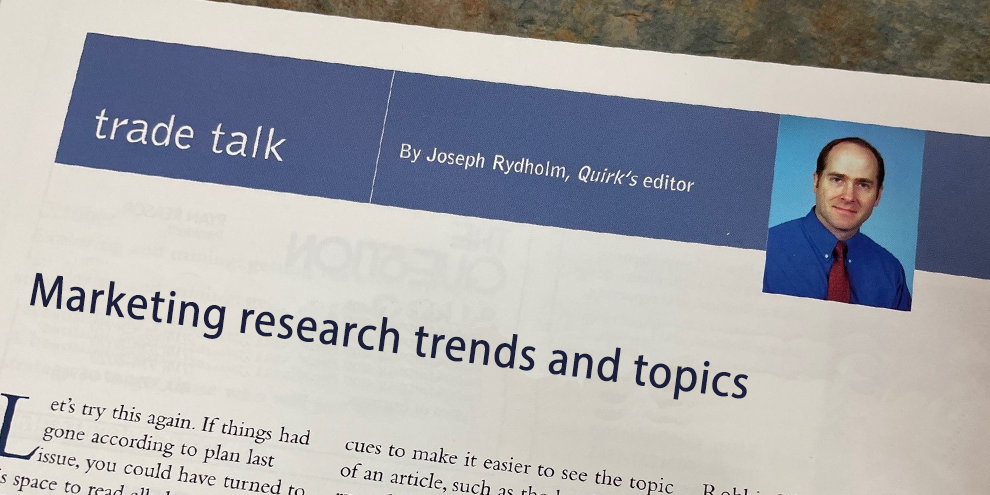Though it fell during the press-time crunch for this issue, I couldn’t resist the lure of spending a few days in Chicago in early May for the IIR’s Technology Driven Market Research Event. Apparently many others were similarly drawn, as organizers said that the event had to be moved to a larger venue after attendance figures passed 200.
As with any conference, there were highs and lows. A few of the presentations had that Trojan Horse feel, where what were ostensibly case studies with vendor and client participation were instead largely sales presentations (tastefully delivered though they were). And some speakers went off course or lost track of time and had to rush through their slide decks.
But in the main, the conference served as a worthwhile and necessary incubator of ideas and discussions on the ways that technology is impacting our industry.
Following is a quick rundown of some of the takeaways I scribbled down in my notes.
Technology helped compensate
Nestlé’s Olga Patel spoke at length about the company’s successful use of eye-tracking, commenting that the technology helped compensate for consumers’ inability to always know precisely what captures their attention or what motivates them. Not that consumers willfully dissemble - they just don’t have the power to recall their second-by-second reactions. And thus, being able to track their gaze path helps Nestlé understand what parts of an ad or package caught their eye. She cited one example where eye-tracking showed that moving a model’s gaze from the viewer to the packaging worked better at directing attention to the product in an ad.
Adding a qualitative element by interviewing consumers following an eye-tracking session has also helped add some depth and color to the findings as this gives consumers a way to talk about why they did what they did, Patel said.
One of her best pieces of advice to her fellow researchers was to be open to using many methods for a project and to tailor your methodology choices to each project’s needs, rather than being tied to one approach.
An audience member asked her if Nestlé had researched if/how kids learn shopping behaviors from their parents and she said that that topic is something the company is currently looking at. She did pass along that Nestlé has found that when parents say things like “I’m looking for healthy ingredients” when in the grocery aisles, kids tend to play that language back when they’re describing shopping. Though, not unexpectedly, kids’ perceptions of what connotes healthfulness (if a frozen treat is red like an apple it must be healthy) won’t always jibe with those of their parents.
Get instant feedback
Vivek Bhaskaran of Survey Analytics and Kevin Keeker of Zynga co-presented on Zynga’s use of research within its many game products. One of the most interesting topics they touched on was that, in lieu of cash or points, Zynga game players who complete short in-game research requests often get instant feedback on how they compare to other respondents - which has not only been well-received by the players but has also saved Zynga money by freeing it from having to always pay some sort of incentive. It begs the question, what else can marketing researchers give to respondents in terms of instant feedback or instant rewards that might not only better engage them and improve their view of the research process but also be more cost-effective for research vendor and client?
Mobile app was critical
Chris Hobson of txteagle moderated a panel of researchers who have conducted app-based mobile research. CareerBuilder’s Sanja Licina said the ability to use a mobile app for research was critical, given the on-the-go nature of the job seekers who use CareerBuilder. She said she likes to be able to put surveys in front of users at a place and time that is convenient for them.
Panelist Lisa Kim of Samsung Electronics said that mobile research has been a helpful complement to the company’s ethnographic-based new product research. In looking to develop products that are one to three years out, Samsung conducts in-home interviews that focus on one type of product, such as laptops. Having respondents perform tasks using a mobile app has worked well as a screening tool, she said, and has also informed the ethnographies by bringing the researchers up to speed on issues relevant to the consumer. It has also made the in-home visits much more focused and effective, as the mobile research essentially takes the place of about 20 minutes of in-depth interviewing and allows that time to be used for other purposes.
Tune out the hype
I was heartened by the fact that once again, as evidenced by the various usage examples I heard in Chicago, researchers seem innately able to tune out the hype surrounding these technologies and see them for what they are: valuable additions to their array of research tools. Apps and other new toys are not replacements for existing research methods but rather ingenious and effective vehicles for adding depth, nuance and new angles to data gathered from other sources.
Further, as our culture becomes more and more mobile and more and more comfortable (perhaps obsessed?) with the social and sharing aspects of technology, it’s imperative that we use that same technology to evolve the research process to give respondents a convenient and engaging survey experience.
